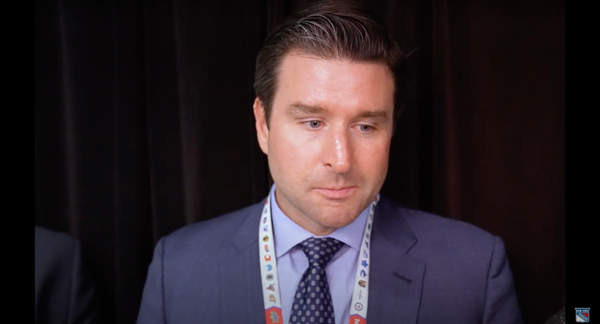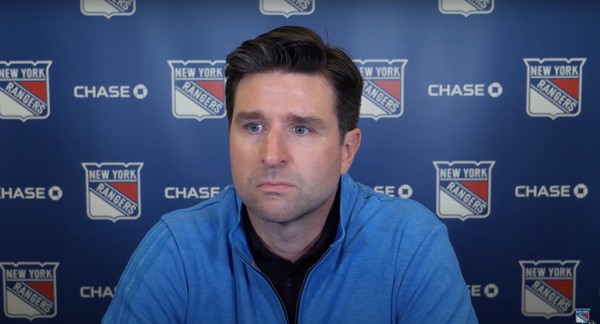Once Upon A Time in RangersTown: Pat LaFontaine
The second entry in a series looking at Rangers who spent a year or less in New York
Welcome to the second edition of “Once Upon A Time in Rangerstown.” The first edition took a look at Markus Näslund, and today we are going to be looking at one of the more interesting and dynamic players in NHL history, Pat LaFontaine.
The Player: Pat LaFontaine | Age 32 | Center
Pat LaFontaine is one of the most prolific players in the history of the NHL whose career was unfortunately cut short by concussions. He had the distinction of playing his entire career in the state of New York and once joked, “‘I think I’m the only player in history who has been traded twice and hasn’t had to change his license plate.” At his peak, LaFontaine was a dynamic offensive player and lethal goal scorer who scored 40 or more goals for six consecutive seasons, including campaigns that saw him tally 46 goals in 57 games in 1991-92, and 53 goals and 148 points in 1992-93. He finished second in the Art Ross that year, as Mario Lemieux put up an impressive line of 69-91-160 in just 60 games after returning to play after being diagnosed with Hodgkin’s lymphoma.
LaFontaine spent the first eight years of his career with the New York Islanders posting a stat line of 287-279-566 in 530 regular season games and 14-22-36 in 50 playoff games. His most famous goal came in a game that is now remembered as the Easter Epic, as the pivotal Game 7 of the Patrick Division Semifinals that started on April 18, 1987 and finally ended at 8:47 of the fourth overtime period on April 19. To this day it is the longest Game 7 in NHL history, and one of only two Game 7’s to require three or more overtimes.
LaFontaine joined the Buffalo Sabres for the 1991-92 season, a year he put up a staggering 0.81 goals per game, and would skate just 268 games over six seasons posting a line of 158 goals and 227 assists for 385 points.
The Deal: September 29, 1997 | Traded to Rangers for 1998 Second Round Pick and Future Considerations
Concussions plagued LaFontaine’s career; he was limited to just 13 games as a 31-year-old during the 1996-97 season. At the time of the trade, LaFontaine had suffered at least five concussions — likely more — but still wanted to play hockey. He was not cleared to join the Sabres for preseason training camp because team doctors deemed he was unfit to play. At the time LaFontaine’s agent Don Meehan suggested that Buffalo wanted to avoid paying his client, and it was easier for them if he remained out.
That led to LaFontaine going to see his own doctors, and he was cleared to play by three neurological specialists. This led to the Rangers and Sabres engaging in dialogue to work out a deal, and one was finalized at the end of September.
The Why: The Rangers had a hole to fill and cash to burn
The Rangers had just lost Mark Messier in free agency to the Vancouver Canucks, and had a spot to fill in their top six at center. A 37-year-old Wayne Gretzky held his own the year before, but there wasn’t anyone within the organization capable of replacing Messier’s production (36-48-84 in 71 games) to back fill as the No. 2 center.
At the time LaFontaine was a risky addition given his injury history, but medically he had been cleared by multiple doctors and he had something to prove. New York also had the cash to pay LaFontaine’s $4.8 million per year salary for two more seasons.
The Season: 25-39-18, 68 points | 5th place in Atlantic Division
The 1996-97 Rangers made it all the way to the Eastern Conference Finals and lost in five games to the Philadelphia Flyers, but the 1997-98 squad was an absolute disaster. The loss of Messier was felt greatly, and it didn’t help that Brian Leetch and Adam Graves saw some regression in their games. It was Leetch’s first full season as team captain, and it was a big responsibility to inherit from Messier. The new responsibility weighed on him, and the player who had just won his second Norris Trophy after tallying 78 points finished the 97-98 campaign with 50 points in 76 games. While still a productive season, it was a dip based on what he’d provided the team in prior seasons. Graves’ production dipped from 61 points to just 35 points, which really hurt the team. The roster as a whole also had some holes, but the dip from the top hurt even though a healthy Alex Kovalev scored 23 goals and tallied 53 points in 73 games.
The Play: 67 games | 23-39-62 | 18:02 ATOI
LaFontaine’s return to action was productive for the Rangers. In his first month with the team he posted a line of 7-5-12 in 14 games. He kicked things into another gear in November and posted an impressive line of 8-13-21 in 14 games. December was a rough month for LaFontaine, as he was held to just one goal and nine points in 14 games, but he rebounded in January posting 12 points in 11 games.
At the All-Star Break he had a respectable 17 goals and 46 points in 47 games. It appeared that the Rangers’ low risk gamble on LaFontaine was paying off even though the team was fourth in their division and eighth in the conference with 44 points.
But unfortunately for the Rangers and LaFontaine, everything went downhill after the All-Star Break. LaFontaine would skate in just 20 games the rest of the season — scoring six goals and adding 10 assists for 16 points — with the final game of his season and career coming on March 16.
The End: LaFontaine suffers career ending concussion vs. Ottawa
During a game vs. the Ottawa Senators, LaFontaine collided with teammate Mike Keane and left the game after logging just 3:09 of ice time. At the time it was thought that the 32-year-old center would be able to overcome what was thought to be a minor head injury, but it ended up being the final game of his career. He would formally announce his retirement, reluctantly, before the start of the 1998-99 season.
“If I had my choice, you bet I’d be suiting up for the New York Rangers this season, the 33-year-old center said during a news conference at Madison Square Garden.”
The story later went on to say:
The collision with Keane resulted in LaFontaine’s sixth diagnosed concussion, a Grade II level injury that followed on the heels of a more severe Grade III blow that knocked him unconscious and cost him the 1996-97 season at Buffalo.
It was an unfortunate end for LaFontaine who ultimately finished his one year on Broadway tied for the team lead in goals and second in points with 62. His stint with the Rangers was a very productive one, and it was difficult for the team to effectively replace him.
LaFontaine was so determined to return to hockey, and it was cruel for his career to be ended after a collision with a teammate. Given the number of concussions suffered, he probably should have retired earlier, but he wanted to go out on his own terms.
When all was said and done, LaFontaine’s career ended at age 33 with a grand total of 468 goals, 545 assists, and 1,013 points despite just playing in just 865 games. He remains one of the more prolific players of 1980s and 1990s, and along with Eric Lindros, is one of those players who had the talent to make many question what could have been had he not suffered so many concussions.
Stats via Hockey-Reference unless otherwise noted





